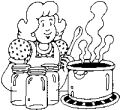|
Home Canning Pickled Beets
Home Canning Pickled Beets... Pickled Beets are wonderful to preserve and it's amazing how fresh they taste even months after they have been canned. There are several different spices you can use. You can purchase a pickling spice or make your own. In this recipe we are just using a traditional blend. To prepare the beets for this recipe you will want to leave the root and 2 inches of the stem on the beet. Beets have a tendency to bleed if you remove these areas too soon. Scrub the beets thoroughly to remove excess dirt and other particles. Put the beets in a large sauce pan and add water until the beets are covered. Bring the beets to a boil and cook until tender. This can be 20-40 minutes depending on the size and quantity of beets you are processing. Remove cooked beets from sauce pan and run cool water over them. You should now be able to easily remove the skin, root and stem of each beet. Now that you have the beets prepared we can continue with the canning process. This recipe makes about six pint jars.
Ingredients for Canning Pickled Beets 3 tbsp - pickling spice 2 1/2 cups - white vinegar 1 cup - water 1 cup - granulated sugar 10 cups - prepared beets
Directions for Canning Pickled Beets 1. Prepare canner, jars and lids. 2. Put the pickling spice in cheesecloth, creating a spice bag. 3. Combine the following into a large stainless steel sauce pan: - vinegar - water - sugar - spice bag 4. Bring to a boil over medium heat and stir until the sugar is dissolved. 5. Reduce the heat and boil for 15 minutes more. 6. Remove the spice bag. 7. Add the beets to the mixture and return to a boil. 8. Remove beets from mixture with a slotted spoon put into hot jars. Leave 1/2 inch of room at top of jar. 9. Ladle the hot pickling liquid into each jar, making sure the beets are covered. Remove air bubbles and add more liquid if required. Again, you want to make sure you leave at 1/2 each of head space at top of each jar. 10. Wipe the rim of each jar and place a lid and band on each. 11. Put the jars in the canner and place lid on top 12. Make sure the jars are completely covered with water. 13. Bring to a boil and process for 30 minutes. 14. Remove canner lid and let cool for 5 minutes. 15. Remove the jars and let cool before storing.
Home Canning Equipment You Will Need - Canning Pickled Beets
Preserving the Good Things in Life!
|



